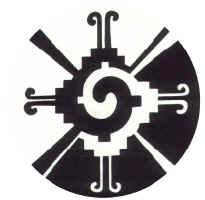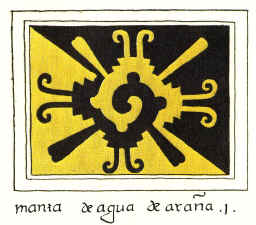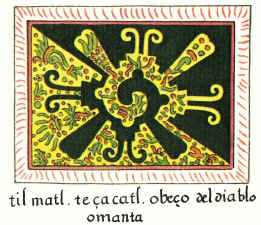“The Origin of the ‘Hunab Ku’ Symbol”
Sept. 24, 2006
http://www.diagnosis2012.co.uk/new10.htm#hunab

The “Hunab Ku” symbol, is widely presumed to be a Maya representation of a major Maya deity and the centre of our Milky Way galaxy. You can find a representation of it at the centre of the Dire Gnosis logo on the index page of this website. Anthropologist John Hoopes recently asked the Year 2012 discussion group if anyone could pinpoint any Maya sculpture, ceramic vessel, or other Precolumbian Maya source where it is shown.
The discussion brought out some interesting facts, summarised as follows:
The symbol became widely known when Jose Arguelles published The Mayan Factor in 1987, where it appears in circular form on the cover of the book, and as part of many illustrations. On p. 32, a rectangular version is labelled “Hunab Ku”, and on p.52, the rectangular version is shown and labelled as “Hunab Ku: One Giver of Movement and Measure”. On p. 30-32, Arguelles explains that in 1968, he visited a little town called Teotitlan del Valle near the Zapotec site of Monte Alban in the mountains of Oaxaca, in central Mexico, and he was shown two rugs with this pattern on them in a textile shop. He bought one in blue and orange.
The connection between the title of Hunab Ku and the design is not explained by Arguelles, but seems to have come via the modern Maya day-keeper, Hunbatz Men. Arguelles says on p.40 that he met Hunbatz Men in 1985, and admits that he was heavily influenced by him. The following year, in 1986, Hunbatz Men published a book in Spanish called Religion Ciencia Maya, (published in 1990 in English as Secrets of Maya Science/Religion), he says that the Mexicas (Aztecs) worshipped Hunab Ku, and they (as well as the Mixtecs), also worshipped the Milky Way, as represented in the “G symbol” (p.40-41). Men calls Hunab Ku “The Only Giver of Movement and Measure”, and at the bottom of p.34 he says that “in order to understand the sacred Hunab Ku…one must venerate the origin of zero, the Milky Way…”.
According to the official Mayanists, such as Sharer, Hunab Ku means “one god” in Yucatec Mayan language, and was the creator of the universe and equivalent to Itzamna, but “Hunab Ku seems to have figured little in the life of the ancient Maya and no representations of Hunab Ku have been identified in the codices or elsewhere.”
In John Major Jenkins’ 1998 book, Maya Cosmogenesis 2012, he shows the rectangular symbol, (p.329) and says it originates in the Nuttall Codex (a pre-conquest Mixtec document named after Zelia Nuttall who identified and published it), but after failing to find it in the the Nuttall codex, Hoopes contacted John Major Jenkins, who said he had seen the symbol as a frontispiece House of the Dawn – in a romance novel by Ryan, published in 1914, and also in an academic work by Zelia Nuttall, but he’d rechecked and it was not in the Nuttall Codex.
Next, I located the symbol in its rectangular form in a 1922 edition of Herbert J. Spinden’s Ancient Civilizations of Mexico and Central America (p.220), with the caption, “Mexican blanket with the design representing sand and water”.
John Major Jenkins finally settled the matter, when he found the rectangular design in the Codex Magliabecchiano, published in 1903, with a commentary by Zelia Nuttall, which is an Aztec document and dates from some time before 601. Hoopes went on to find that the codex shows variations of the rectangular design, and says they are “mantas” – mantles or ritual cloaks that were used in festivals – in particular, the festival of lip plugs. The word for lip plug was originally mistranslated as spider water, which is given in the caption.
So, in summary, the “Hunab Ku” symbol was originally a rectangular symbol used by the Aztecs as a ritual cloak design, known as the Mantle of Lip Plugs (or, arguably, mantle of spider water). The symbol survives as a rug design being sold in central Mexico, but was associated with the Milky Way and the god Hunab Ku by Jose Arguelles in 1987, who changed the symbol to a circular one. This is how the symbol appeared in the 16th century Codex Magliabecchiano:





















































































































